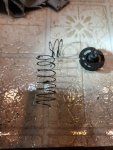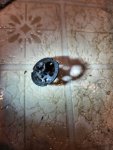Toolslinger
Well-known member
- 146
- 332
- 63
- Location
- PA
So, while cleaning out the vintage crud in the bottom of the 802a, I came across these two items... I have no idea what they are, and while I'm not really concerned, I'm curious. I simply expect these are remnants from some prior repair that got dropped, or launched, and weren't easily found... That said, I'd take a look at whatever they're part of if I knew what it was.







